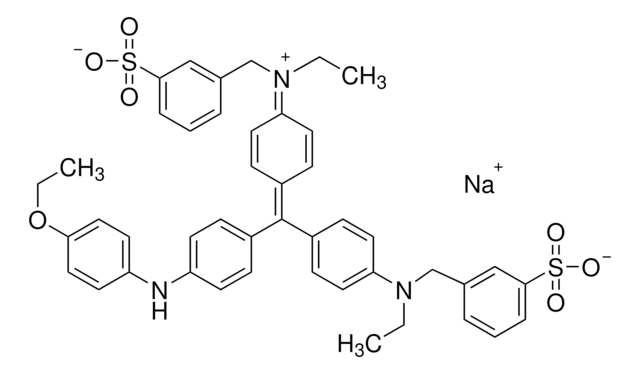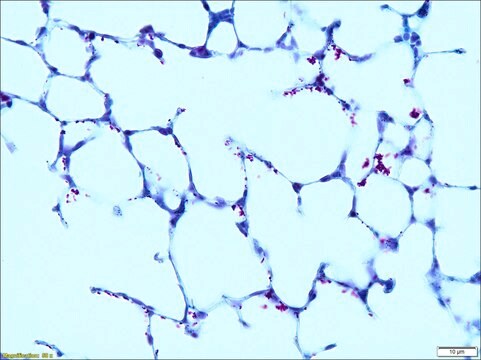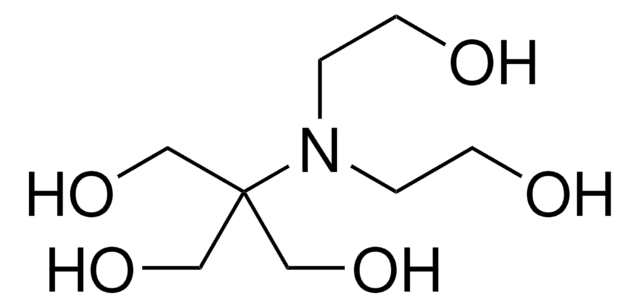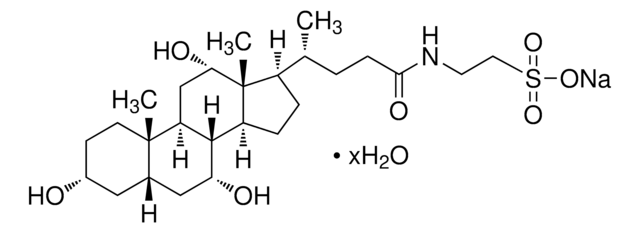V900412
Tricine
Vetec™, reagent grade, ≥99%
Synonym(s):
N-[Tris(hydroxymethyl)methyl]glycine
Sign Into View Organizational & Contract Pricing
All Photos(3)
About This Item
Linear Formula:
(HOCH2)3CNHCH2CO2H
CAS Number:
Molecular Weight:
179.17
Beilstein:
1937804
EC Number:
MDL number:
UNSPSC Code:
12161700
PubChem Substance ID:
Recommended Products
grade
reagent grade
product line
Vetec™
Assay
≥99%
form
crystalline powder
useful pH range
7.4-8.8
pKa (25 °C)
8.1
SMILES string
OCC(CO)(CO)NCC(O)=O
InChI
1S/C6H13NO5/c8-2-6(3-9,4-10)7-1-5(11)12/h7-10H,1-4H2,(H,11,12)
InChI key
SEQKRHFRPICQDD-UHFFFAOYSA-N
Looking for similar products? Visit Product Comparison Guide
General description
Tricine is the most used electrophoresis buffer, which has a lower negative charge than glycine. This in turn helps it to migrate faster. Tricine is also used for the resuspension of cell pellets. Moreover, its high ionic strength leads to more movement of ions and less protein movement. This aids to separate low molecular weight proteins in lower percent acrylamide gels. Tricine is also used as a trailing ion that helps in the resolution of small proteins at lower acrylamide concentrations compared to glycine-sodium dodecyl-sulfate polyacrylamide gel electrophoresis (SDS-PAGE) systems.
Application
Buffer component for separation of low molecular weight peptides.
Legal Information
Vetec is a trademark of Merck KGaA, Darmstadt, Germany
Storage Class Code
13 - Non Combustible Solids
WGK
WGK 3
Flash Point(F)
Not applicable
Flash Point(C)
Not applicable
Choose from one of the most recent versions:
Already Own This Product?
Find documentation for the products that you have recently purchased in the Document Library.
Customers Also Viewed
Encyclopedia of Dairy Sciences (2011)
Hermann Schägger
Nature protocols, 1(1), 16-22 (2007-04-05)
Tricine-SDS-PAGE is commonly used to separate proteins in the mass range 1-100 kDa. It is the preferred electrophoretic system for the resolution of proteins smaller than 30 kDa. The concentrations of acrylamide used in the gels are lower than in
Arpita Gantayet et al.
Biofouling, 29(1), 77-85 (2012-12-06)
The freshwater zebra mussel (Dreissena polymorpha) is a notorious biofouling organism. It adheres to a variety of substrata underwater by means of a proteinaceous structure called the byssus, which consists of a number of threads with adhesive plaques at the
Christian Nilsson et al.
Electrophoresis, 31(3), 459-464 (2010-02-02)
Totally porous lipid-based liquid crystalline nanoparticles were used as pseudostationary phase for capillary electroseparation with LIF detection of proteins at physiological conditions using unmodified cyclic olefin copolymer capillaries (Topas, 6.7 cm effective length). In the absence of nanoparticles, i.e. in
Thierry Rabilloud
Journal of proteomics, 73(8), 1562-1572 (2010-04-17)
Electrophoretic separations of proteins are widely used in proteomic analyses, and rely heavily on SDS electrophoresis. This mode of separation is almost exclusively used when a single dimension separation is performed, and generally represents the second dimension of two-dimensional separations.
Our team of scientists has experience in all areas of research including Life Science, Material Science, Chemical Synthesis, Chromatography, Analytical and many others.
Contact Technical Service










